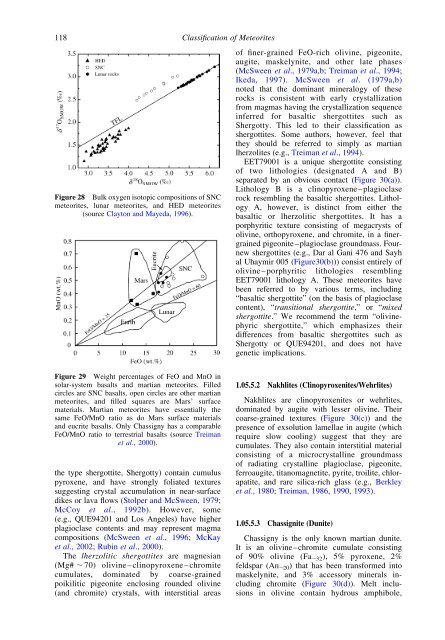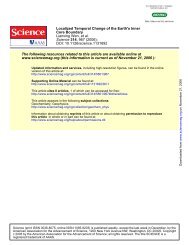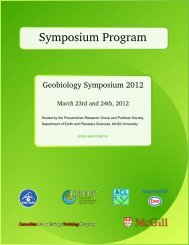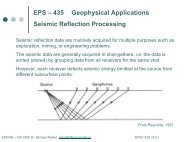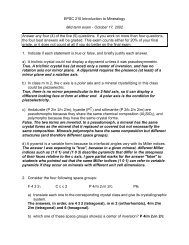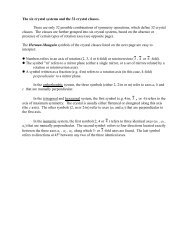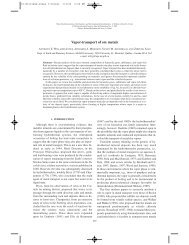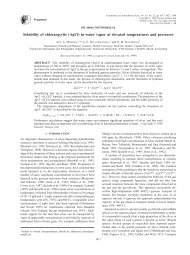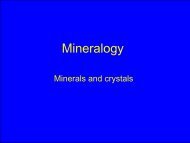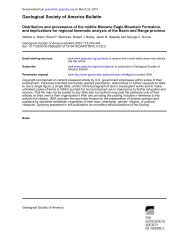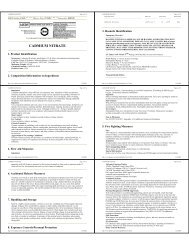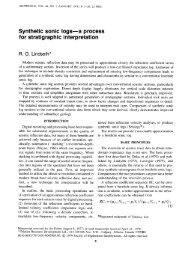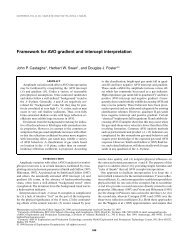05 Classification of.. - Department of Earth and Planetary Sciences
05 Classification of.. - Department of Earth and Planetary Sciences
05 Classification of.. - Department of Earth and Planetary Sciences
Create successful ePaper yourself
Turn your PDF publications into a flip-book with our unique Google optimized e-Paper software.
118<br />
Figure 28 Bulk oxygen isotopic compositions <strong>of</strong> SNC<br />
meteorites, lunar meteorites, <strong>and</strong> HED meteorites<br />
(source Clayton <strong>and</strong> Mayeda, 1996).<br />
<strong>Classification</strong> <strong>of</strong> Meteorites<br />
<strong>of</strong> finer-grained FeO-rich olivine, pigeonite,<br />
augite, maskelynite, <strong>and</strong> other late phases<br />
(McSween et al., 1979a,b; Treiman et al., 1994;<br />
Ikeda, 1997). McSween et al. (1979a,b)<br />
noted that the dominant mineralogy <strong>of</strong> these<br />
rocks is consistent with early crystallization<br />
from magmas having the crystallization sequence<br />
inferred for basaltic shergottites such as<br />
Shergotty. This led to their classification as<br />
shergottites. Some authors, however, feel that<br />
they should be referred to simply as martian<br />
lherzolites (e.g., Treiman et al., 1994).<br />
EET79001 is a unique shergottite consisting<br />
<strong>of</strong> two lithologies (designated A <strong>and</strong> B)<br />
separated by an obvious contact (Figure 30(a)).<br />
Lithology B is a clinopyroxene–plagioclase<br />
rock resembling the basaltic shergottites. Lithology<br />
A, however, is distinct from either the<br />
basaltic or lherzolitic shergottites. It has a<br />
porphyritic texture consisting <strong>of</strong> megacrysts <strong>of</strong><br />
olivine, orthopyroxene, <strong>and</strong> chromite, in a finergrained<br />
pigeonite–plagioclase groundmass. Fournew<br />
shergottites (e.g., Dar al Gani 476 <strong>and</strong> Sayh<br />
al Uhaymir 0<strong>05</strong> (Figure30(b))) consist entirely <strong>of</strong><br />
olivine–porphyritic lithologies resembling<br />
EET79001 lithology A. These meteorites have<br />
been referred to by various terms, including<br />
“basaltic shergottite” (on the basis <strong>of</strong> plagioclase<br />
content), “transitional shergottite,” or “mixed<br />
shergottite.” We recommend the term “olivinephyric<br />
shergottite,” which emphasizes their<br />
differences from basaltic shergottites such as<br />
Shergotty or QUE94201, <strong>and</strong> does not have<br />
genetic implications.<br />
Figure 29 Weight percentages <strong>of</strong> FeO <strong>and</strong> MnO in<br />
solar-system basalts <strong>and</strong> martian meteorites. Filled<br />
circles are SNC basalts, open circles are other martian<br />
meteorites, <strong>and</strong> filled squares are Mars’ surface<br />
materials. Martian meteorites have essentially the<br />
same FeO/MnO ratio as do Mars surface materials<br />
<strong>and</strong> eucrite basalts. Only Chassigny has a comparable<br />
FeO/MnO ratio to terrestrial basalts (source Treiman<br />
et al., 2000).<br />
the type shergottite, Shergotty) contain cumulus<br />
pyroxene, <strong>and</strong> have strongly foliated textures<br />
suggesting crystal accumulation in near-surface<br />
dikes or lava flows (Stolper <strong>and</strong> McSween, 1979;<br />
McCoy et al., 1992b). However, some<br />
(e.g., QUE94201 <strong>and</strong> Los Angeles) have higher<br />
plagioclase contents <strong>and</strong> may represent magma<br />
compositions (McSween et al., 1996; McKay<br />
et al., 2002; Rubin et al., 2000).<br />
The lherzolitic shergottites are magnesian<br />
(Mg# , 70) olivine–clinopyroxene–chromite<br />
cumulates, dominated by coarse-grained<br />
poikilitic pigeonite enclosing rounded olivine<br />
(<strong>and</strong> chromite) crystals, with interstitial areas<br />
1.<strong>05</strong>.5.2 Nakhlites (Clinopyroxenites/Wehrlites)<br />
Nakhlites are clinopyroxenites or wehrlites,<br />
dominated by augite with lesser olivine. Their<br />
coarse-grained textures (Figure 30(c)) <strong>and</strong> the<br />
presence <strong>of</strong> exsolution lamellae in augite (which<br />
require slow cooling) suggest that they are<br />
cumulates. They also contain interstitial material<br />
consisting <strong>of</strong> a microcrystalline groundmass<br />
<strong>of</strong> radiating crystalline plagioclase, pigeonite,<br />
ferroaugite, titanomagnetite, pyrite, troilite, chlorapatite,<br />
<strong>and</strong> rare silica-rich glass (e.g., Berkley<br />
et al., 1980; Treiman, 1986, 1990, 1993).<br />
1.<strong>05</strong>.5.3 Chassignite (Dunite)<br />
Chassigny is the only known martian dunite.<br />
It is an olivine–chromite cumulate consisting<br />
<strong>of</strong> 90% olivine (Fa ,32 ), 5% pyroxene, 2%<br />
feldspar (An ,20 ) that has been transformed into<br />
maskelynite, <strong>and</strong> 3% accessory minerals including<br />
chromite (Figure 30(d)). Melt inclusions<br />
in olivine contain hydrous amphibole,


